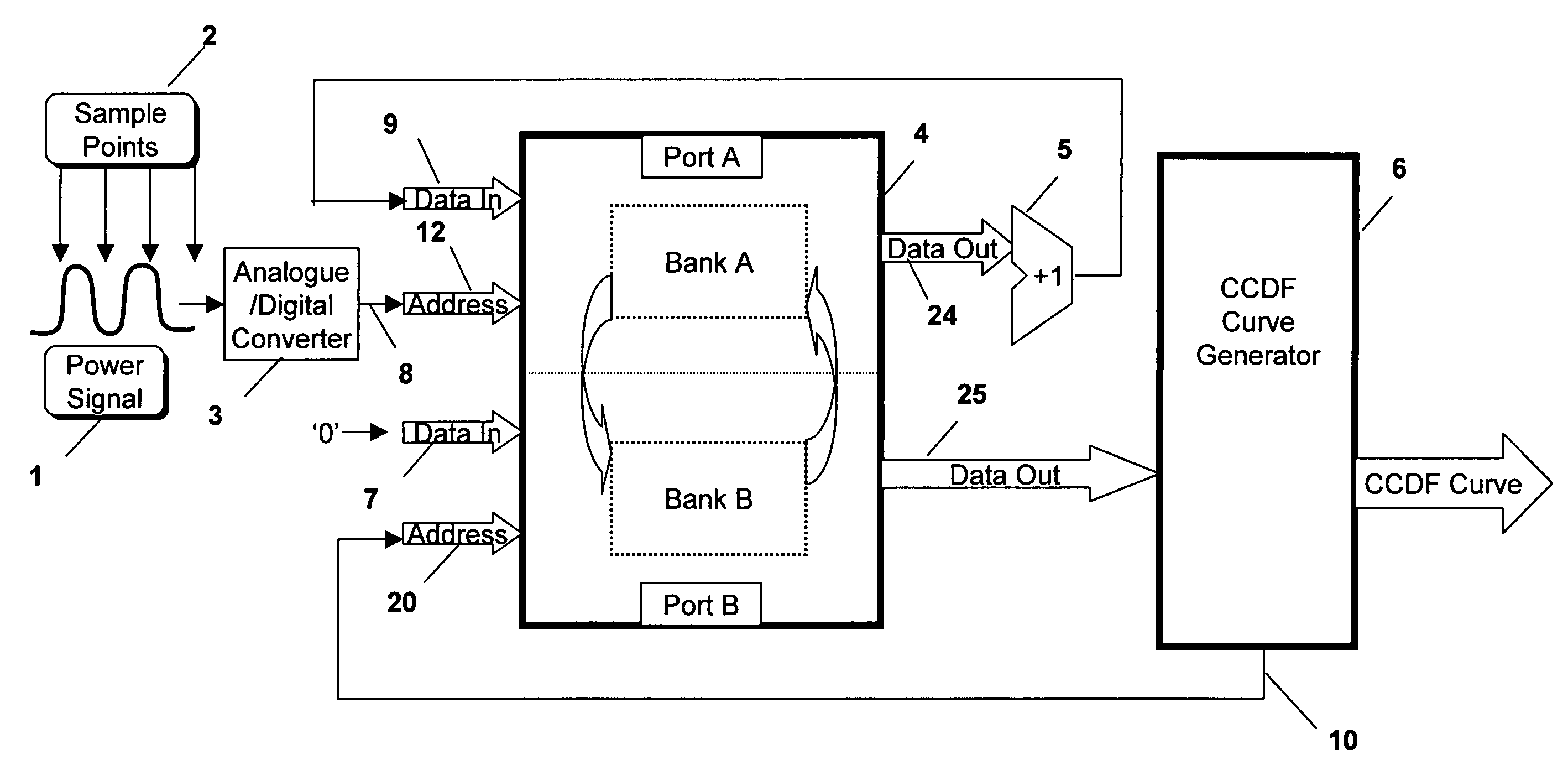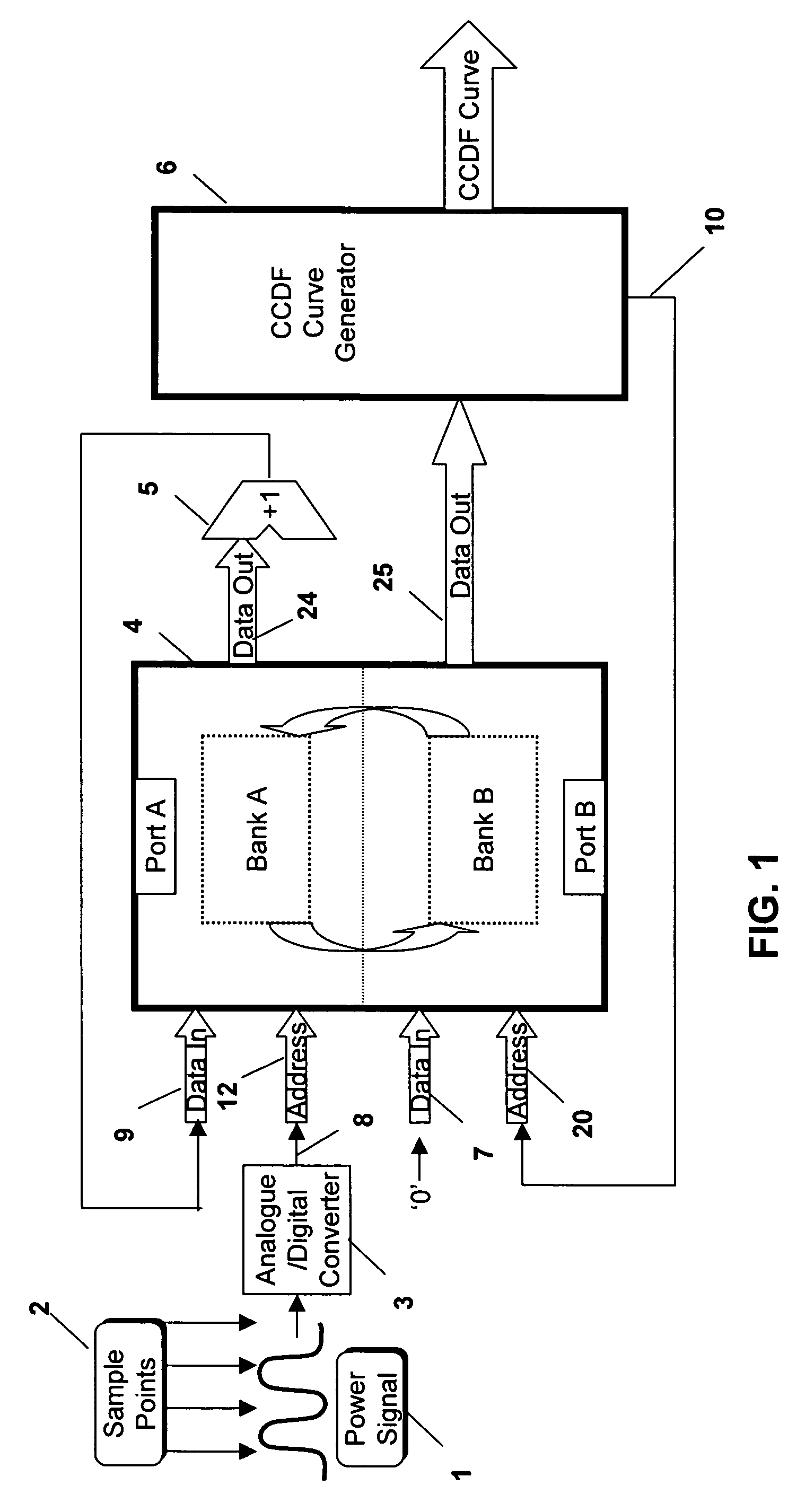Apparatus and method for generating a complementary cumulative distribution function (CCDF) curve
a cumulative distribution and curve technology, applied in the field of appratus and method for generating a complementary cumulative distribution function (ccdf) curve, can solve the problems of ten samples, high distortion, and missing the elusive high peak level, and achieve the effect of reducing length and shortening bit length data words
- Summary
- Abstract
- Description
- Claims
- Application Information
AI Technical Summary
Benefits of technology
Problems solved by technology
Method used
Image
Examples
second embodiment
[0036] Both problems are overcome in the invention, which will now be described with reference to FIG. 2, where the same elements as those in FIG. 1 are designated using the same numerals for ease of reference. In this embodiment, in order to allow the data to be read out to the CCDF curve generator 6, the capture is halted for a short period of time periodically to allow the memory to be read out using one of the ports. The apparatus includes a controller 12 which is used to control a counter 13 for presenting a count value to a first multiplexer 14. The controller 12 sets the counter to count down from one of two possible counts so as to have, effectively, two different time periods. During a first, longer, time period, the apparatus is used in “data capture” mode to capture the required data to the memory 4 and in the second, shorter, time period, the apparatus is used in “read” mode to read the contents of the memory 4 out to a second memory 16.
[0037] Thus, the output 8 of the A...
first embodiment
[0038] If the apparatus is in the “read” mode, then the controller 12 controls the multiplexer 14 to pass the count value from the counter 13 to its output. This count value is used as the address at the address input 20 of Port B of the memory 4 and the contents of that address in the memory is read out at data output 25 to the second memory 16. Clearly, therefore, as the counter 13 cycles through all the count values, each address is read out to the second memory 16 and when the counter 13 times out, all the addresses have been read and the counter is again initialised by the controller to count the time period for the “data capture” mode. If desired, as the addresses are read out to the second memory 16, the data can be set to zero, as described above with reference to the
[0039] As long as the apparatus is in the “data capture” mode, the comparator 15 receives the address from the ADC at its first input and the address from the ADC from the previous clock cycle, which has been pa...
third embodiment
[0045]FIG. 4 shows the present invention, where, again, the same elements as in the previous embodiments are designated with the same numerals for ease of reference. In this case, as can be seen, the memory 4, the second memory 16, and some of the circuit elements including the first latch 17 and the comparator 15, form a histogram capturing block 42. In this embodiment, a data word 43 from the ADC output 8 is passed to a third multiplexer 44, which is used to pass a selected number of bits of the data word through to a third latch 45. The output of this third latch 45 provides the address passed to the address input 19 of Port A of the memory 4, as well as to the first multiplexer 14 and to the first input of comparator 15, as in the previous embodiment.
[0046] In this embodiment, the apparatus includes a plurality of similar histogram capturing blocks 42, each having the same inputs and outputs as the one shown in FIG. 4. Each histogram capturing block 42 is used to capture data in...
PUM
 Login to View More
Login to View More Abstract
Description
Claims
Application Information
 Login to View More
Login to View More - R&D
- Intellectual Property
- Life Sciences
- Materials
- Tech Scout
- Unparalleled Data Quality
- Higher Quality Content
- 60% Fewer Hallucinations
Browse by: Latest US Patents, China's latest patents, Technical Efficacy Thesaurus, Application Domain, Technology Topic, Popular Technical Reports.
© 2025 PatSnap. All rights reserved.Legal|Privacy policy|Modern Slavery Act Transparency Statement|Sitemap|About US| Contact US: help@patsnap.com



